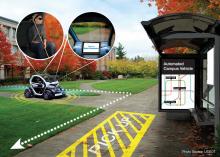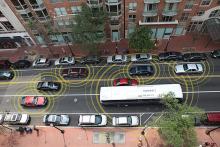The implementation of in-vehicle systems will require multilateral cooperation, as Honda’s Sue Bai explains to Colin Sowman.
Vehicle manufacturers will shape the future direction of in-vehicle ITS systems, but they can’t do it on their own. So to find out what they see on the horizon, and the obstacles they face, ITS International spoke to Sue Bai, principal engineer in the Automobile Technology Research Department with Honda R&D Americas. Not only does she play an important role in Honda’s US-based ITS

Sue Bai, principal engineer in the Automobile Technology Research Department with Honda R&D Americas
The implementation of in-vehicle systems will require multilateral cooperation, as Honda’s Sue Bai explains to Colin Sowman.
Vehicle manufacturers will shape the future direction of in-vehicle ITS systems, but they can’t do it on their own. So to find out what they see on the horizon, and the obstacles they face,1846 ITS International spoke to Sue Bai, principal engineer in the Automobile Technology Research Department with 5400 Honda R&D Americas. Not only does she play an important role in Honda’s US-based ITS research, she also chairs the SAE International DSRC Technical Committee which leads efforts to standardise safety related vehicle-to-vehicle (V2V) and vehicle-to-infrastructure (V2I) messages and data dictionary using J2735 and J2945(draft).
Over the next five to 10 years she says many vehicle manufacturers are expecting to be installing collision warning systems and other safety-related technology incorporating dedicated short range communications (DSRC). “If these systems can give two or three seconds warning of an impending incident, that would be useful,” she says. “But five to 10 seconds of heads-up to avoid getting into the last second imminent collision situation would be even better.” However, she adds the caveat that road-side infrastructure support such as DSRC equipment will be required to fully achieve the safety benefit.
She views the installation of roadside equipment as a ‘game changer’ for the vehicle manufacturers. “Without the roadside equipment, the in-vehicle systems that will be available would be less attractive to car buyers. We know that car buyers may not want to invest in such a system if they have the only vehicle on the road within 200 miles using this technology and are looking at ways to conquer that adoption issue.
“Although the safety benefit of incorporating V2V DSRC technology can be significant, when most people are buying a car they don’t do so thinking they will have an accident. Therefore short-range collision avoidance may not be that tempting a prospect. The majority of car buyers will drive for many years without having an accident but they will encounter traffic lights many times every day. So buyers would see the value in investing in a system that effectively meant traffic lights turn green just as they reached the intersection or tells them 100 metres from the junction that they won’t make the lights so back off the accelerator and save gas. The traffic light phase and timing information is also critical for warning a distracted driver from unintentionally running through a red light.”
Bai says that even with a small percentage of vehicles outfitted with the technology, the benefit could be spread among many drivers. “If one driver gets advanced information to reduce speed when approaching a set of traffic lights, then those following will also have to slow down. So not only does the vehicle outfitted with the technology pass through the junction without stopping, so do the others that are following - they also benefit.”
The same is true of a V2I system that avoids late lane changing by advising drivers which lane to select ahead of a junction, or automatically alerts drivers of stationary traffic around the next bend. Such technology would not only avoid many car accidents but also the subsequent traffic delays, personal injuries and the cost of clearing the wreckage.
She believes there are sound socio-economic reasons why road authorities, both commercial organisations and public bodies, should invest in DSRC infrastructure and sees European road operators, automotive OEMs and roadside equipment manufacturers as leading the way out of the current ‘which should come first’ situation. Indeed Bai would like to see similar initiation in the US pushing forward the inclusion of V2I systems.
Furthermore, she believes the exclusive DSRC spectrum use would help guarantee the quality of the DSRC safety message exchange. The DSRC safety system deployment can become challenging if the ITS industry loses interference-free access to 5.9 GHz spectrum.
“While some may say the ITS industry hasn’t made use of the spectrum, there are many examples where technology has a long gestation period and we’ve only had 5.9 for 14 years. There are many incidents where fledgling technology has taken much longer to come to market. Considering the critical nature of safety-related use of the DSRC spectrum, the highly regulated and litigated nature of the automobile manufacturing industry in the US, thorough research is necessary even if it takes time.”
For vehicle manufacturers to install cooperative systems, those systems must be robust and reliable. “Most of the major car manufacturers have proven prototypes but these systems can’t be put into production vehicles unless the over-the-air messages work with high reliability.”
This leads Bai on to one of her major areas of research, looking at the best ways to introduce these technologies during this early stage of adoption. “According to one of USDOT’s studies on V2V penetration growth outlook, it can take more than 20 years before the V2V cooperative system exposure rate reaches above 90%. So for the immediate future no cooperative system can be foolproof as long as the potential remains for older vehicles to be used on the road,” she says.
And while it may be possible to develop a basic form of retrofit technology, the legislative framework to require such installations in existing vehicles may not exist. Federal level regulation mainly covers new vehicle production. In addition, in the US the regulations and legislations vary state by state, which could pose further challenges for OEMs, as well as the aftermarket industry. Such concerns are debated at SAE meetings where Bai and others strive to ensure various global regions, nations and states adopt common standards and protocols for such systems.
“We need global collaboration,” says Bai, adding that progress is being made in this area. “Each region is doing its own research and not surprisingly, when the engineers started talking they found they were all working on similar applications. So now we are looking at working towards common standards. That is why I am working with Japanese and European vehicle manufacturers and road authorities that are trying to align their standards - at least at the application level. It makes sense for cooperative systems to comply with common standards when possible, and this is acknowledged among many of the major road operators and the vehicle manufacturers.”
When it is suggested that utilising mobile phone infrastructure and technology to communicate information to-and-from vehicles to speed ITS deployment, Bai is sceptical about safety applications. “It might be suitable for information that is not time-critical but the mobile phone company would be unlikely to dedicate part of its capacity to information exchange among vehicles and infrastructure with guaranteed transmission reliability.”
Such problems are compounded on the global stage as Bai explains: “I had this problem when I travelled from Stuttgart to Vienna. My phone worked perfectly well in Stuttgart and Vienna but when I stopped near Salzburg, I had zero coverage. Even excluding time-sensitive information, those in our industry have to really examine the cellular service option closely before considering it in place of DSRC, even for less time-critical applications. Such a move might seem a shortcut to ITS deployment but the impact to the quality of in-vehicle service and the benefit to the driver must be carefully examined.”
This rather encapsulates her philosophy on ITS deployment, which is that it is not enough that a service is available. “Drivers must trust and act on what their in-vehicle system is telling them before it can really qualify as being ‘deployed’.”
Now that’s a standard on which everybody can agree.
Vehicle manufacturers will shape the future direction of in-vehicle ITS systems, but they can’t do it on their own. So to find out what they see on the horizon, and the obstacles they face,
Over the next five to 10 years she says many vehicle manufacturers are expecting to be installing collision warning systems and other safety-related technology incorporating dedicated short range communications (DSRC). “If these systems can give two or three seconds warning of an impending incident, that would be useful,” she says. “But five to 10 seconds of heads-up to avoid getting into the last second imminent collision situation would be even better.” However, she adds the caveat that road-side infrastructure support such as DSRC equipment will be required to fully achieve the safety benefit.
She views the installation of roadside equipment as a ‘game changer’ for the vehicle manufacturers. “Without the roadside equipment, the in-vehicle systems that will be available would be less attractive to car buyers. We know that car buyers may not want to invest in such a system if they have the only vehicle on the road within 200 miles using this technology and are looking at ways to conquer that adoption issue.
“Although the safety benefit of incorporating V2V DSRC technology can be significant, when most people are buying a car they don’t do so thinking they will have an accident. Therefore short-range collision avoidance may not be that tempting a prospect. The majority of car buyers will drive for many years without having an accident but they will encounter traffic lights many times every day. So buyers would see the value in investing in a system that effectively meant traffic lights turn green just as they reached the intersection or tells them 100 metres from the junction that they won’t make the lights so back off the accelerator and save gas. The traffic light phase and timing information is also critical for warning a distracted driver from unintentionally running through a red light.”
Bai says that even with a small percentage of vehicles outfitted with the technology, the benefit could be spread among many drivers. “If one driver gets advanced information to reduce speed when approaching a set of traffic lights, then those following will also have to slow down. So not only does the vehicle outfitted with the technology pass through the junction without stopping, so do the others that are following - they also benefit.”
The same is true of a V2I system that avoids late lane changing by advising drivers which lane to select ahead of a junction, or automatically alerts drivers of stationary traffic around the next bend. Such technology would not only avoid many car accidents but also the subsequent traffic delays, personal injuries and the cost of clearing the wreckage.
She believes there are sound socio-economic reasons why road authorities, both commercial organisations and public bodies, should invest in DSRC infrastructure and sees European road operators, automotive OEMs and roadside equipment manufacturers as leading the way out of the current ‘which should come first’ situation. Indeed Bai would like to see similar initiation in the US pushing forward the inclusion of V2I systems.
Furthermore, she believes the exclusive DSRC spectrum use would help guarantee the quality of the DSRC safety message exchange. The DSRC safety system deployment can become challenging if the ITS industry loses interference-free access to 5.9 GHz spectrum.
“While some may say the ITS industry hasn’t made use of the spectrum, there are many examples where technology has a long gestation period and we’ve only had 5.9 for 14 years. There are many incidents where fledgling technology has taken much longer to come to market. Considering the critical nature of safety-related use of the DSRC spectrum, the highly regulated and litigated nature of the automobile manufacturing industry in the US, thorough research is necessary even if it takes time.”
For vehicle manufacturers to install cooperative systems, those systems must be robust and reliable. “Most of the major car manufacturers have proven prototypes but these systems can’t be put into production vehicles unless the over-the-air messages work with high reliability.”
This leads Bai on to one of her major areas of research, looking at the best ways to introduce these technologies during this early stage of adoption. “According to one of USDOT’s studies on V2V penetration growth outlook, it can take more than 20 years before the V2V cooperative system exposure rate reaches above 90%. So for the immediate future no cooperative system can be foolproof as long as the potential remains for older vehicles to be used on the road,” she says.
And while it may be possible to develop a basic form of retrofit technology, the legislative framework to require such installations in existing vehicles may not exist. Federal level regulation mainly covers new vehicle production. In addition, in the US the regulations and legislations vary state by state, which could pose further challenges for OEMs, as well as the aftermarket industry. Such concerns are debated at SAE meetings where Bai and others strive to ensure various global regions, nations and states adopt common standards and protocols for such systems.
“We need global collaboration,” says Bai, adding that progress is being made in this area. “Each region is doing its own research and not surprisingly, when the engineers started talking they found they were all working on similar applications. So now we are looking at working towards common standards. That is why I am working with Japanese and European vehicle manufacturers and road authorities that are trying to align their standards - at least at the application level. It makes sense for cooperative systems to comply with common standards when possible, and this is acknowledged among many of the major road operators and the vehicle manufacturers.”
When it is suggested that utilising mobile phone infrastructure and technology to communicate information to-and-from vehicles to speed ITS deployment, Bai is sceptical about safety applications. “It might be suitable for information that is not time-critical but the mobile phone company would be unlikely to dedicate part of its capacity to information exchange among vehicles and infrastructure with guaranteed transmission reliability.”
Such problems are compounded on the global stage as Bai explains: “I had this problem when I travelled from Stuttgart to Vienna. My phone worked perfectly well in Stuttgart and Vienna but when I stopped near Salzburg, I had zero coverage. Even excluding time-sensitive information, those in our industry have to really examine the cellular service option closely before considering it in place of DSRC, even for less time-critical applications. Such a move might seem a shortcut to ITS deployment but the impact to the quality of in-vehicle service and the benefit to the driver must be carefully examined.”
This rather encapsulates her philosophy on ITS deployment, which is that it is not enough that a service is available. “Drivers must trust and act on what their in-vehicle system is telling them before it can really qualify as being ‘deployed’.”
Now that’s a standard on which everybody can agree.











